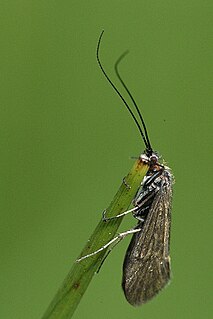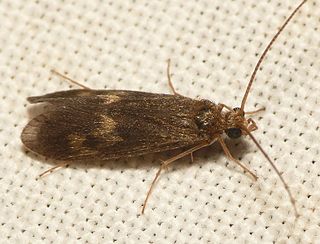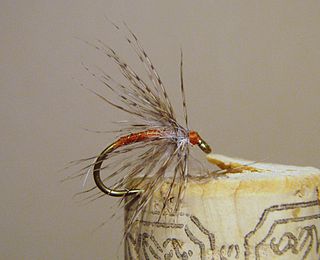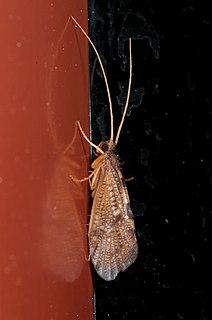Related Research Articles

Flies are insects of the order Diptera, the name being derived from the Greek δι- di- "two", and πτερόν pteron "wing". Insects of this order use only a single pair of wings to fly, the hindwings having evolved into advanced mechanosensory organs known as halteres, which act as high-speed sensors of rotational movement and allow dipterans to perform advanced aerobatics. Diptera is a large order containing an estimated 1,000,000 species including horse-flies, crane flies, hoverflies and others, although only about 125,000 species have been described.

In evolutionary ecology, a parasitoid is an organism that lives in close association with its host at the host's expense, eventually resulting in the death of the host. Parasitoidism is one of six major evolutionary strategies within parasitism, distinguished by the fatal prognosis for the host, which makes the strategy close to predation.

The caddisflies, or order Trichoptera, are a group of insects with aquatic larvae and terrestrial adults. There are approximately 14,500 described species, most of which can be divided into the suborders Integripalpia and Annulipalpia on the basis of the adult mouthparts. Integripalpian larvae construct a portable casing to protect themselves as they move around looking for food, while Annulipalpian larvae make themselves a fixed retreat in which they remain, waiting for food to come to them. The affinities of the small third suborder Spicipalpia are unclear, and molecular analysis suggests it may not be monophyletic. Also called sedge-flies or rail-flies, the adults are small moth-like insects with two pairs of hairy membranous wings. They are closely related to the Lepidoptera which have scales on their wings; the two orders together form the superorder Amphiesmenoptera.
Robert McLachlan FRS was an English entomologist specializing in the study of lacewings (Neuroptera) and caddisflies (Trichoptera).

Alexandr Pavlovich Rasnitsyn is a Russian entomologist, expert in palaeoentomology, and Honored Scientist of the Russian Federation (2001). His scientific interests are centered on the palaeontology, phylogeny, and taxonomy of hymenopteran insects and insects in general. He has also studied broader biological problems such as evolutionary theory, the principles of phylogenetics, taxonomy, nomenclature, and palaeoecology. He has published over 300 articles and books in several languages. In August 2008 he was awarded the Distinguished Research Medal of the International Society of Hymenopterists.
Nannochoristidae is a family of scorpionflies with many unusual traits. It is a tiny, relict family of about eight species, with members of the genus Nannochorista occurring in New Zealand, southeastern Australia, Tasmania, and Chile, so is probably of Gondwanan origin. The adults look like scorpionflies with more pointed, elongated wings. Most mecopteran larvae are eruciform, or shaped like caterpillars. Nannochoristid larvae, however, are elateriform, or shaped like wireworm or click beetle larvae. They are also the only entirely aquatic Mecoptera. Wing venation suggests a close relationship to dipterans. They are predatory, primarily on the larvae of aquatic Diptera.
Dry fly fishing is an angling technique in which the lure is an artificial fly which floats on the surface of the water and does not sink below the surface. Developed originally for trout fly fishing, it is sometimes regarded as the supreme fishing sport, owing to its difficulty in both manual dexterity and understanding of the fish in its environment.

The Hydropsychidae are a family-level taxon consisting of net-spinning caddisflies. Hydropsychids are common among much of the world's streams, and a few species occupy the shorelines of freshwater lakes. Larvae of the hydropsychids construct nets at the open ends of their dwellings which are responsible for their "net-spinning caddisfly" common name.

The Ecnomidae are a family of caddisflies comprising 9 genera with a total of 375 species.

The Polycentropodidae are a family of trumpet-net and tube-making caddisflies. There are at least 30 genera and 720 described species in Polycentropodidae. The type genus for Polycentropodidae is Polycentropus J. Curtis, 1835.
Hubert Duprat is a French artist known for his unusual work, an artistic intersection between caddisfly larvae and gold, opal, turquoise and other precious stones.

Agriotypinae is a subfamily of ichneumonid parasitoid wasps found in the Palaearctic region. This subfamily contains only one genus, Agriotypus. The known species are aquatic idiobiont ectoparasitoids of Trichoptera pupae.

The Partridge and Orange is an artificial fly commonly categorized as a wet fly or soft hackle and is fished under the water surface. The fly is a very well known fly with its roots set firmly in English angling history. It is an impressionistic pattern fished successfully during caddis hatches and spinner falls. The Partridge and Orange is traditionally a trout and grayling pattern but may be used for other aquatic insect feeding species.

The Ulan Malgait Formation is a Late Jurassic geologic formation in Mongolia. Dinosaur remains are among the fossils that have been recovered from the formation, although as of 2004 none have yet been referred to a specific genus.

The Elk Hair Caddis is a dry fly commonly used for trout fishing. The Elk Hair Caddis was created by Pennsylvania fly tyer Al Troth in 1957. He is considered a pioneer in the sport of fly fishing for this invention.
Dicosmoecus is a genus of october caddis in the family Limnephilidae. There are about six described species in Dicosmoecus.
Martin Ephraim Mosely was an English entomologist who specialized in the systematics of caddisflies (Trichoptera). His interest in freshwater insects was first triggered by his interest in fishing. He was also a well-known angler and fly-fisherman and contributed to the works of Frederic M. Halford, a friend and distant relative.
Anisocentropus krampus is a species of caddisfly in the family Calamoceratidae. It was described in 1994 by Austrian entomologist Hans Malicky and found in New Britain.

Hymenopterida is a superorder of insects, comprising Hymenoptera and the orders of Panorpida . The superorder is a member of Endopterygota and most closely related to the orders of Neuropterida and Coleopterida.

Oeconesidae is a family of caddisflies in the order Trichoptera. There are about 6 genera and 19 described species in Oeconesidae, found mainly in New Zealand. A single species, Tascuna ignota, is found in Tasmania.
References
Citations
- ↑ Sukacheva 1968, pp. 202–206.
- ↑ Belaveya, Quicke & Rasyntyn 2002, p. 213.
Bibliography
- Belaveya, N. V.; Quicke, Donald; Rasyntyn, A. P. (2002). History of Insects. Dordrecht, Ma: Kluwer Academic Publishers. ISBN 0-306-475-77-4.
- Sukacheva, D. (1968). "Mesozoic caddis flies (Trichoptera) of Transbaykalia". Paleontological Journal.